Climate extremes
 This winter will be long remembered for two extreme events; the floods of November and the cold of December and January. Neither broke many records in the longer view of things. But both left salutary reminders that Irish society works on an assumption of a continuation of the status quo and has not yet grasped the reality that some extremes may become a regular feature of life, John Sweeney writes.
This winter will be long remembered for two extreme events; the floods of November and the cold of December and January. Neither broke many records in the longer view of things. But both left salutary reminders that Irish society works on an assumption of a continuation of the status quo and has not yet grasped the reality that some extremes may become a regular feature of life, John Sweeney writes.
Ireland has its fair share of climate extremes. In 1887 we had our highest recorded temperature of 33.3oC at Kilkenny Castle and our lowest recorded annual rainfall of 357mm at Glasnevin. By contrast, two-thirds of this annual total fell in one day at Cloone Lake in County Kerry in 1993.
For much of Ireland, the November floods were the result of a sustained rainfall not experienced since August 1986, the wet summer when ‘Hurricane Charley’ paid its respects.
It was not the intensity of the rainfall which was the problem, rather it was the duration of falls occurring onto already saturated soils and impermeable surfaces such as built-over floodplain, that caused the problems so tragically highlighted in the media.
Climate models suggest such flood events will become more frequent and more severe and while uncertainties exist, for a river such as the Boyne, the projections imply that the event which today occurs typically every 25 years could be happening every eight to 10 years by mid century and every two to three years by the 2080s.
The bitterly cold weather around the turn of the year reflected a temporary reversal of normal meteorological controls over large parts of the northern hemisphere. Normally at this time of year a cold spell is caused by the great Siberian anticyclone extending its influence westwards and deflecting our Atlantic storms into the Mediterranean or around the North Cape of Norway. The jet-streams which act as the ‘curtain rails’ for such storms usually lie to the north of Ireland. This year was fundamentally different. From late December a large blocking anticyclone became established over Iceland and an Arctic airflow was directed. The flow enveloped much of western Europe and was accompanied by anomalously cold conditions. December 2009 was the second snowiest on record in the Northern Hemisphere. Beijing had its heaviest snowfall since the 1950s, while oranges froze and tropical fish died in Florida. Places such as northern Finland cooled to below -30oC, while parts of Siberia, normally colder, enjoyed anomalously warm temperatures.
Once established, positive feedback occurs in a blocking system of this nature and clear skies over a cold, snow-covered, surface promotes further cooling. This was manifested on January 7th when Oak Park in County Carlow cooled to -12.1oC, and the following night when Casement Aerodrome in Dublin hit -12.4oC, a new record for that location.
Despite this, few records were broken. Ireland’s coldest night was on January 16th, 1881 when the mercury tipped -19.1oC in Markree Castle, County Sligo. The 20th century’s coldest night was -18.8oC at Lullymore, County Kildare. But winter 2009/10 came as a bit of a shock to the system in the middle of a long period of warming winters. On average winter nights today are 1.3oC warmer than in the 1960s.
It is important to stress that both the floods and the cold were weather extremes. Even as Irish climate warms we will occasionally have a bitterly cold winter. It is the frequency of such events that will diminish. By contrast the frequency of floods can be expected to increase substantially with wetter winters.
So winter 2009/10 does not provide any justification for relaxing our efforts to combat climate change. Indeed the decade 2000 to 2009 has now emerged as the warmest decade globally since records began. Weather is not climate and while the cold may become more of a rarity, the floods will not.
Leading climatologist, Professor John Sweeney has been a lecturer at the geography department at NUI Maynooth since 1978. Over the past 30 years he has published approximately 60 scientific papers and co-authored four texts on various aspects of climatology and climate change in Ireland.





